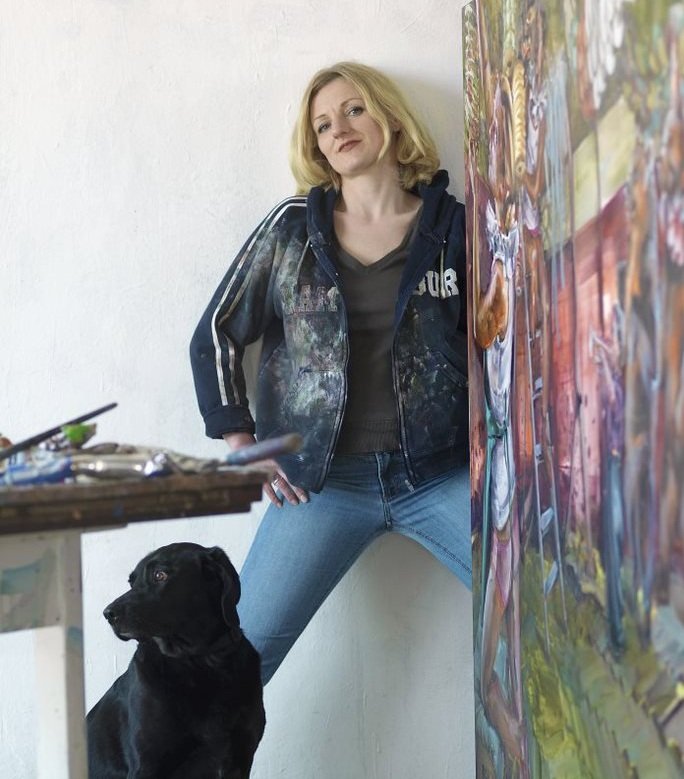Justine Otto
Justine Otto: In my paintings, I find it particularly exciting to explore the border between figuration and abstraction. My most recent works include figurative elements in addition to completely abstract passages. I like the contrast between complete detachment, where the painting is completely free, unrestricted of a (signifying) form - and figuration, in which ratio is predominant. I try to achieve this by varying the density of different techniques.
Over the years I have developed a wide range of techniques from which I can draw: there is spraying, wet-on-wet painting, taping, scraping, leveling out, dissolving all, stamping, working with various tools. I like it when dissimilar techniques come together and the entire object merges into a resonant image. There are no taboos. Being courageous and challenging oneself is part of what painting is for me. My ‘‘Black Paintings’’ series, which was inspired by old black-and-white photos of public officials and generals, is about breaking up and deconstructing these traditional ‘archetypes’, literally in painting.
Justine Otto Interview
1. Hi Justin, can you tell us about your background. How and when did you first start to paint?
I started painting at a very early age. My mother loved to paint, but it was impossible to make a carrier of it in Poland at that time and she became a teacher. I remember painting gardens with lots of tulips when I was four years old. At the same time, I also remember that I was incredibly happy to design small cemeteries for birds that fell from the roof. I think that was the desire to work in space as well, this is why I now always supplement my painting with sculptural ceramics. After finishing school in Germany I started to study Free Painting at the Städelschule in Frankfurt, which is the smallest but a well - known public art academy in Germany.
2 . What is your process like? How do you begin to work?
There are always themes in my work that run like red threads from one work to the next. Most of the time I first make sketches that let an idea crystallize first. Then there are collages that condense the idea and at some point, I start painting, whereby the collage only forms a framework for me and painting can go its own way.
3 . What is your main source of inspiration?
Nearly everything... of course, there are phases in life where one or the other is more in the foreground. At the moment it's nature, why I spend a lot of time outside. I'm fascinated by the abundance of all organic forms.
4. What does your artwork represent?
I find it particularly exciting to explore the border between figuration and abstraction. My most recent works include figurative elements in addition to completely abstract passages. I like the contrast between complete detachment, where painting is completely free, unrestricted by the limitation of a (signifying) form – and figuration, in which ratio is predominant. I try to achieve this by varying the density of different techniques. Over the years I have developed a wide range of techniques from which I can now draw: there is spraying, wet-on-wet painting, taping, scraping, leveling out, dissolving all, stamping, working with various tools. I like it when dissimilar techniques come together and the entire object merges into a resonant image. There are no taboos. Being courageous and challenging oneself is part of what painting is for me.
5. As you mentioned, your ‘’Black Painting’’ series is about breaking up and deconstructing archetypes traditional. Can you explain more about this topic?
When I started painting, I primarily painted girls and women, whom I painted very figuratively. At some point, I broke away from that topic. I started to paint more male figures and at the same time, my painting became more and more abstract, the forms began to dissolve. I became interested in generals, soldiers, and statesmen in their uniforms because they were such traditional symbols of power, but now I was able to dissolve them in abstract painting. Then, for example, medals became geometric circles, and the forms dissolved into ornaments or loops. The whole thing became very free and playful. That’s what my ‘’Black Painting’’ series is about. From then on, I dealt with many male archetypes, such as the Marlboro men. It appealed to me to look at these clichés of smoking lonely cowboys riding on the prairie through a modern lens.










